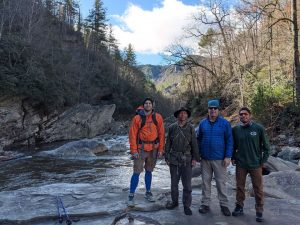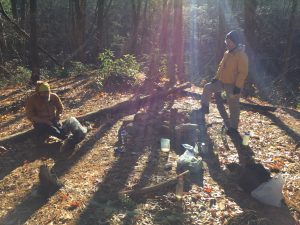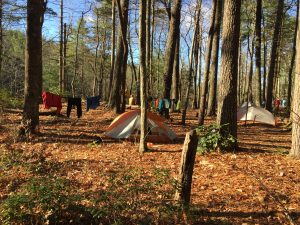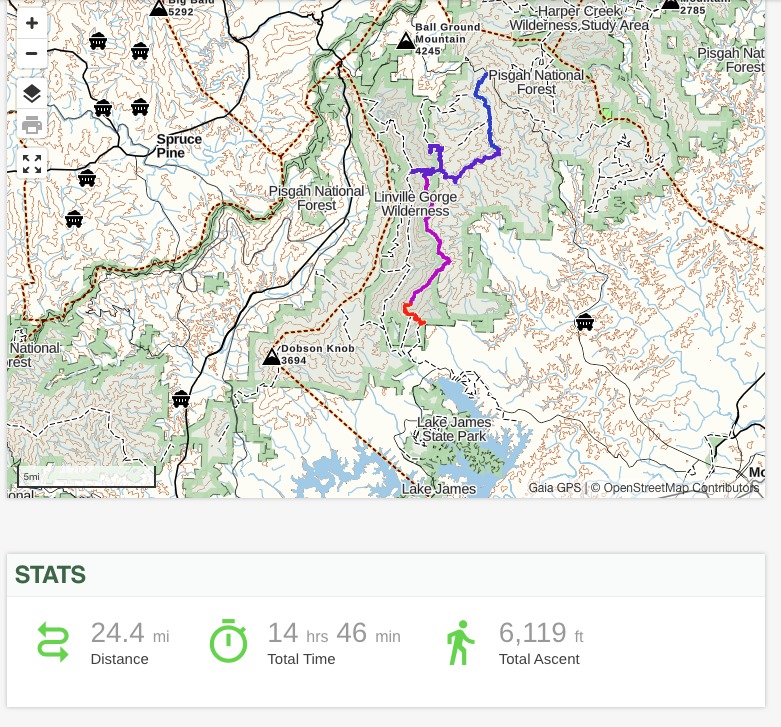Evening of Day Two–Making Fire in the Rain

After a challenging wet hike on Day Two (see part one here) me and my comrades went into our individual tents to dry off, warm up, and recuperate from a prolonged cold exposure.
When I finally crawled out of my sleeping bag and tent a couple hours later at twilight the rain had stopped. My comrades were working getting a fire going. How in the world would this happen when every stick in sight was drenched? It turned out the leader of this trip had a technique for making a fire starter by putting lint inside a cardboard egg carton and dipping it in wax. It was an amazing tiny fire starter which was virtually bulletproof in the rain. Another guy carved some slivers of kindling from a fallen limb. It took some time and coaxing and there was a big cheer when the little fire finally caught and flared up. The sticks we stacked up in tipi fashion around the fire starter started catching and then from there we carefully placed and more limbs at just the perfect timing across the ever increasing flame. There is an art too knowing when the fire is strong enough to dry off another limb so the limb can then increase the fire.
Fire became an essential tool on this backpacking trip as I came to appreciate it more than I ever had. There wasn’t one of us there that had successfully saved our clothes. Our experiences were similar in that everything we had worn that day was in a wet heap to the corner of each of our individual tents. And also, we each had saved one bit of clothing and our sleeping bags by wrapping in a protective bag and/or pack cover. After we each made some dinner we started drying our clothing articles by holding near the fire. This isn’t always recommended since a flying ember can burn a hole instantly through most fabrics. Also it is easy to overheat something by placing too close to the flame. However we were willing to take the risk.

I started with my waxed cotton windbreaker and was delighted to find it dried quickly and was not prone to easily being hurt by the heat or an ember. Then I went for socks and base layer. You could see the steam coming off as the water left. It could have been considered a drudgery however, just the thought of having dry clothes in the morning to start the day propelled us on as we each took turns sharing the warm flame, holding clothing articles either in our two hands or sometimes using a stick, and chatting and laughing as the whole prospect of comfort kept improving.
That night was extremely windy and we were happy we decided to camp down inside the Linville Gorge canyon instead of at the top as originally planned. I put on my base layer, wool socks, wool sweater and wrapped my head in a merino bandana. The extreme wind tested my open tarp to the max and while I was laying there I wished I had pitched it lower but at this point there was no changing it. All night the wind whipped around swirling as I listened to the trees creaking and rustling and my tarp pushed around but did not fail. I slept extremely cozy using my breath as heat, feeling myself dry out and thaw out, and woke up to a surprise…the sunrise was coming up over the mountain and the skies were blue!
The temps dropped to about 40 which actually wasn’t nearly as cold as we expected. You just never know how things are going to turn out on a backpacking trip.
We made another fire to sit around while having breakfast then left our camp right there and started off on a day hike a couple miles down to the bottom of the Linville Gorge.
I have never eaten so well on a backpacking trip. My new paleo recipes were delicious and provided vital warmth and energy. Our trip leader made it super easy by boiling a big pot of water that we each could pour over whatever food or beverage we brought along. I explained to my new friends what I was eating and they could barely comprehend. I was having Blueberry Pemmican…which is an ancient Native American recipe. The very Cherokee Indians most likely ate the same thing centuries ago as they were living and hunting in these same lands. Dried meat and berries which are then pulverized and mixed with rendered lard (animal fat) to make a nutrient dense, mouth watering, life giving food. Plus there is no cooking involved, you just pull it out and start eating. It only takes a few bites to be completely satisfied and ready to hit the trail. Add to that a cup of coffee with dried milk and generous chunks of butter and you have a powerhouse trail breakfast.
We hung our remaining wet clothing articles on lines strung between trees to dry as we hiked. At this point I don’t think any of us were trying to set any records but mostly just wanted an enjoyable experience. Putting one’s body up against nature in its extremes has a way of humbling a person. I took off my shoes and shirt and hiked pack-free while enjoying the morning sun on my skin.
The day was the lowest and then the highest points of our hikes as we went down to the wild Linville River and then back to camp to pack up and hike with packs up to the highest point of Table Rock Mountain. From there we hiked on the Mountains to Sea Trail to a camp in the Wilson Creek Wilderness. Again, more fires, more testing of my tarp and natural fiber gear, however this time without rain. It was a delight to camp near a creek which we approached in the dark and pitched camp and made fire again in the dark.
I was extremely pleased with my open air tarp and natural fiber moisture wicking gear. Camping near a creek can feel cold in the winter because of the dampness. And this is just what I love because where before the gear works counter to the circumstances, here my wool set up was ideal. The others were going in their tents trying to protect their down from absorbing moisture which would weaken it’s thermal abilities. I felt warm and dry, slept amazing, and my friends almost had to wake me up since I was still asleep after they were done with breakfast.







